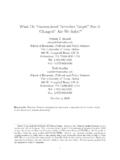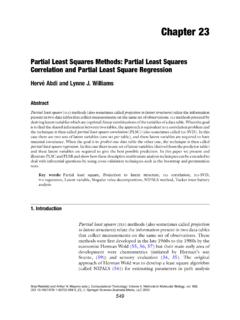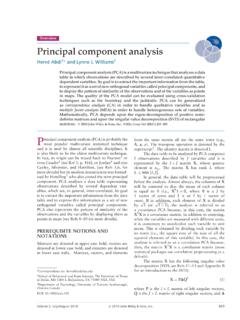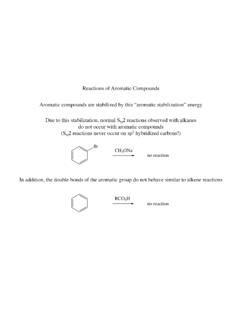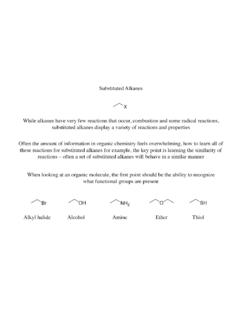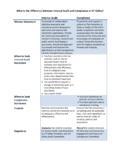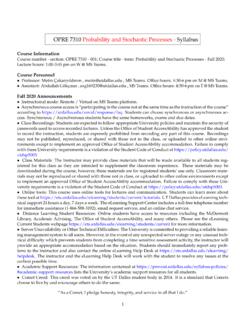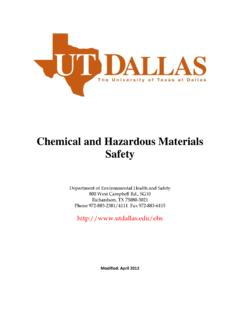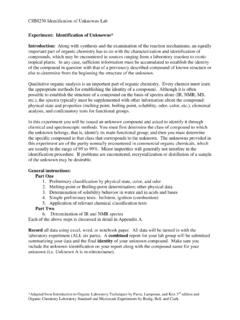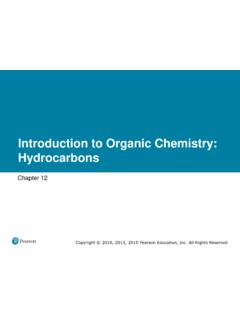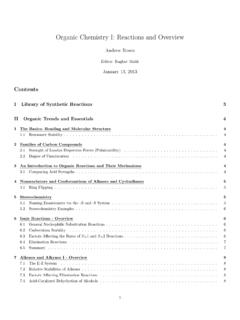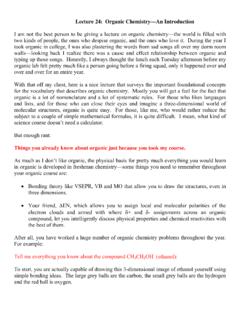Transcription of INTRODUCTION TO ORGANIC NOMENCLATURE - utdallas.edu
1 INTRODUCTION TO ORGANIC NOMENCLATUREALKANES, HYDROCARBONS, and FUNCTIONAL GROUPS. All ORGANIC compounds are made up of at least carbon andhydrogen. The most basic type of ORGANIC compound is one made up exclusively of sp3 carbons covalently bonded to other carbonsand hydrogens through sigma bonds only. The generic name for this family of compounds is alkanes. Alkanes are part of a moregeneral category of compounds known as hydrocarbons. Some hydrocarbons such as alkenes and alkynes contain sp2 or sp-hybridized carbon are of great importance to the different classification systems and the naming of ORGANIC compounds because they consistof a carbon chain that forms the main structural unit of all ORGANIC substances. When an alkane carbon chain is modified in anyway, even by the mere INTRODUCTION of an sp2 carbon or a heteroatom (atoms other than carbon and hydrogen), is is said to befunctionalized. In other words, a functional group has been introduced and a new class of ORGANIC substances has been functional group is a specific arrangement of certain atoms in an ORGANIC molecule that becomes the center of reactivity.
2 Thatis, it is the portion of the structure that controls the reactivity of the entire molecule and much of its physical properties. Anentire classificaton system of functional groups is based on atom hybridization. Some of these functional groups are presentedon page 2. They are the most commonly studied in introductory ORGANIC chemistry NOMENCLATURE . Since alkanes are the most fundamental types of ORGANIC compounds, their structural features (abasic carbon chain, or skeleton) provide the basis for the NOMENCLATURE of all ORGANIC compounds. The earliest nomenclaturesystems followed almost no systematic rules. Substances were named based on their smell, or their natural source, etc. Many ofthose names are still in use today and are collectively known as common names. As ORGANIC chemistry developed and structuresbecame more complex, a systematic method for naming ORGANIC compounds became necessary. The International Union of Pureand Applied chemistry (IUPAC) is the organism that sets the rules for NOMENCLATURE of ORGANIC compounds today.
3 Names thatfollow IUPAC rules are known as systematic names, or IUPAC to IUPAC rules, the first four alkanes are called methane, ethane, propane, and butane. They contain one, two, three,and four carbon atoms respectively, in a linear arrangement. Beginning with the fifth member of the series, pentane, the numberof carbons is indicated by a greek prefix (penta, hexa, hepta, etc.). Most ORGANIC chemistry textbooks contain tables of at least thefirst ten members of the series, along with their structures and physical properties. Thus, the first two and most elementary rulesfor naming alkanes are to identify the length of the carbon chain, start the name with the appropriate greek prefix, and end thename with the suffix -ane. All this is obvious from the examples just given. Other rules are discussed OF FUNCTIONAL GROUPS BASED ON ATOM HYBRIDIZATIONI. HYDROCARBONS - Substances containing only carbon and sp3 carbon present (technically not a functional group)ALKENESCCAt least one -bond between two sp2 carbons presentALKYNESCCAt least one triple bond between two sp carbons presentII.
4 ALKYL HALIDES, OR HALOALKANES - Substances containing at least one C-X bond, where X=F, Cl, Br, or FLUORIDESCFALKYL CHLORIDESCClALKYL BROMIDESCBrALKYL IODIDESCIIII. GROUPS CONTAINING OXYGEN - Both carbon and oxygen can be sp3 or sp2 hybridized, or a combination of OxygenALDEHYDESCHOandKETONESCCOCsp2 OxygenCARBOXYLIC ACIDSCOHO,ESTERSCOOC, andANHYDRIDESCOOCO These functional groups contain both sp3 and sp2 , OR ACYL HALIDESCXO The most common halogens used are chlorine and GROUPS CONTAINING NITROGEN - They may also contain other elements. For example amides also contain (sp3 Nitrogen),AMIDESCNO, andNITRILESCN (sp Nitrogen)Before proceeding, it is important to emphasize that beginning ORGANIC chemistry students must get used to seeing alkane chainsfrom different angles, perspectives, and positions, as shown below using line-angle formulas for linear ALKANES and ALKYL GROUPS.
5 When naming branched alkanes by IUPAC rules, identify and name the longestcontinuous carbon chain first. Then identify the branch, or branches. The branches are called alkyl groups. For example, a onecarbon branch is called a methyl group. The names of alkyl groups are the same as those of analogous alkanes, except that theirnames end in -yl, instead of -ane. The following are examples of the most common alkyl groups encountered in introductory organicchemistry courses. Alky groups never exist by themselves. In alkanes they are always attached to a higher priority chain and aretherefore sometime called substituents. The point of attachement is indicated by a the following example, the longest continuous carbon chain has five carbons. Therefore the parent alkane is pentane. Thereis a methyl group attached to this chain. The molecule is then named methylpentane. Finally, the exact position of the methylgroup is specified by numbering the main chain from the end closest to the methyl group.
6 The complete IUPAC name for this alkaneis the following examples the alkyl groups are shown in red. Students must get used to line-angle formulas as early as sure you ve identified the longest continuous carbon chain correctly. Otherwise you might end up with the wrong name. Thelongest continuous carbon chain doesn t always have to be a horizontal row of carbons. It can take twists and turns. That s whyone must get used to visualize molecules from different angles and perspectives. The following example illustrates the correctname and an incorrect name based on a horizontal row of correct name above illustrates what s done when there are several substituents of the same kind. First identify their positions,then use the prefixes di-, tri-, tetra-, etc. to indicate how many are :2-IsopropylpentaneCORRECT:2,3-Dimethylh exane2,4-Dimethylpentane2,5,6-Trimethyln onaneIf there are substituents of different kinds present, name them in alphabetical order ( ethyl before methyl).
7 Prefixes such asdi-, tri-, tetra-, etc. are ignored when ,6-dimethylheptane2,6-Dimethyl-4-propyln onaneIf there are several options for choosing the longest continuous carbon chain, choose the one that yields the simplest name. Thatmeans:(a) The longest continuous carbon chain has the greatest number of substituents, and(b) The name has the lowest set of numbers indicating the substituent alky groups (those which are branched themselves) are named as if they were alkanes, but the name ends in -yl andis enclosed in parenthesis. The carbon from which the substituent atttaches to the main chain is automatically number :2,6-Dimethyl-4-propyloctaneINCORRECT:5- Isobutyl-3-methyloctane3substituentsofsi mplerstructure,andalowersetofpositionnum bers2substituentsofmorecomplexstructure, andagreatersetofpositionnumbers123456789 123pointofattachementtothemainchain(1-Me thylpropyl)group5-(1-Methylpropyl)nonane Although common alkyl group names such as isopropyl and t-butyl are commonly used as part of IUPAC names, strict IUPAC rulescall for naming them as complex substituents.
8 Common names are used because they are easier to say, shorter, and save paperand ink in scientific publications when they have to be used repeatedly in : COMMON NAMES. Like alkyl groups, alkanes can also have common names. Common, or trivial names are rarelyused for straight chain alkanes, but are frequently used for branched alkanes. The following pages contain some terminology thatorganic chemistry students must memorize or become familiar with, due to the fact that it is widely used in textbooks and in thechemical and ISOALKYL GROUPS. The iso structural unit consists of two methyl groups attached to a common this unit is present in an alkane or alky group, the common name starts with the prefix :IsopropylgroupIUPACNAME:(1-Methylethyl) 4-IsopropyloctaneAcceptableandcommonlyus edname4-(1-Methylethyl)octaneCorrectIUPA C name,butcumbersomeforroutineuseCH3 CHCH3orTheisostructuralunitWhen this unit is present in alkanes, the molecule is named according to the total number of carbon atoms present, but thename starts with the prefix iso.
9 The smallest possible isoalkane is then same rules apply to isoalkyl groups, but their names end in -yl. The smallest possible isoalky group is the isopropyl group,because alkyl groups are always attached to another carbon ,or(1-Methylethyl)Theisobutylgroup,or(2- Methylpropyl)Theisopentylgroup,or(3-Meth ylbutyl)PRIMARY, SECONDARY, AND TERTIARY CARBONS. Another bit of terminology associated with common names refers to theconnectivity of sp3 carbons in alkanes and alkyl groups. A primary carbon is one that is covalently attached to only one othercarbon. A secondary carbon is one attached to two other carbons. A tertiary carbon is attached to three other carbons. Thisdefinition implies that methane cannot have any such carbons, since it consists of only one carbon atom. Likewise, this terminologyapplies only to sp3 carbons. Other types are not defined in this way. In the following examples the carbons in question areindicated as (1o)carbonssecondary(2o)carbonstertiary( 3o)carbonsundefinedThe carbon atoms directly engaged -bonding in alkenes are referred to as vinylic.
10 An sp3 carbon directly attached to a vinyliccarbon is referred to as allylic. Finally, an sp3 carbon directly attached to a benzene ring is referred to as it is emphasized that this is terminology used in common names, it is widely used and therefore important. It constitutesthe basis for characterizing not only alkanes, but also other types of compounds where the main functionality is attached to acarbon that belongs to one of the types described. Thus we can have primary alcohols, secondary chlorides, allylic hydrogens,etc. based on the type of carbon to which they are terminology is also used to identify the point of attachment of certain alkyl groups to the main chain of a molecule, based onthe type of carbon from which the alkyl group connects to the main chain. For example four different butyl groups are possible,depending on their structure and their point of attachemnt to the main carbon chain.
